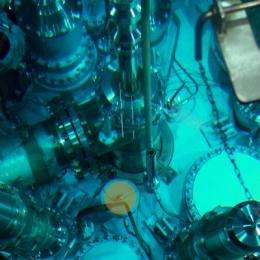Cancer diagnosis isotopes from Garching

The German Federal Ministry of Health has awarded more than one million euros in research and development funding for the efficient production of an important cancer diagnostic agent at the research neutron source FRM II. In a 2009 feasibility study, the Technische Universitaet Muenchen demonstrated that due to the high neutron flux the neutron source in Garching can produce about half of the European demand of the radioisotope molybdenum-99.
Approximately seventy thousand patients undergo scintigraphic tests every day throughout the world. About 70 percent of these tests are performed with technetium-99m for the diagnosis of tumors. Necessary for the production of technetium-99m is its parent isotope molybdenum-99, most of which is produced in just five neutron sources worldwide. If production at one of these sources temporarily pauses, vital investigations have to be postponed. Therefore nuclear medicine physicians have long been calling for an upgrade of the Garching research neutron source for production of molybdenum-99.
Now the Federal Health Ministry has pledged to support the development of an efficient radiation process at Garching's research neutron source. Subsidies amounting to one million euros are allocated for the years 2011 and 2012. In addition, the State of Bavaria is supporting the construction with 1.2 million euros for personnel and material resources.
During the current ongoing maintenance and upgrading work, the FRM II has already installed a thimble in which the molybdenum-99 will be produced in the future. The aim of further research is to produce significantly higher specific activity than existing production facilities. This includes not only measures for efficient cooling of the material in a position with highest neutron flux, but also more efficient packaging processes for safe and speedy delivery of the short-lived isotope for further radiopharmaceutical processing.
The Scientific Director of the FRM II, Prof. Dr. Winfried Petry, said: "The funding helps us to develop more efficient methods for the production of the isotope. Therewith Germany provides an important contribution to Europe's supply of radioisotopes for nuclear medicine."
Already in clinical use, there is another isotope that is produced at TUM's neutron source, lutetium-177. It is mainly used to treat endocrine tumors such as gastrointestinal tumors. In cooperation with the firm Isotope Technologies Garching GmbH (ITG), the research neutron source produces lutetium-177 for the treatment of about 50 patients per week.
Provided by Technische Universitaet Muenchen















